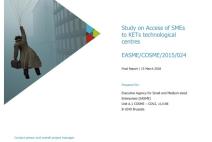
3D printing of hybrid components
While 3D printing of hybrid components represents a niche market, it entails interesting insights for the deployment and commercialisation of 3D printed products. The value chain of metal 3D printing...
The EMI project is partially inspired by the Advanced Technologies for Industry project, which has also delivered several reports on the development and uptake of advanced technologies. This section contains all the reports produced by the ATI project.

While 3D printing of hybrid components represents a niche market, it entails interesting insights for the deployment and commercialisation of 3D printed products. The value chain of metal 3D printing...
While the electronics sector was traditionally driven by the consumer electronics market, this has recently been overtaken by markets more closely related to embedded electronics. Semiconductors have...
Industry 4.0 is radically changing the way of farming in Europe. However, most farmers do not yet adopt digital technologies or only invest in proven technologies. Many farmers remain sceptical about...
While biotech flavours and fragrances (F&F) represent a niche, they may yet constitute an interesting example for an entry point to commercialise products based on synthetic biology, which is...
European industry is facing technological, socio-political and climate change challenges. The transition to climate neutrality is the most urgent challenge of our times and calls for bold and...
The ATI Website focuses on the advanced technologies that will enable and help industries to successfully manage a shift towards a low-carbon and knowledge-based economy. 16 Advanced technologies have...

This study has inventoried 1358 Technology Centres offering services to SMEs to innovate with Key Enabling Technologies (KETs) in the EU28. 47% are located in 5 Member States, 24% are located in EU13...
Inspired by similar initiatives implemented in Germany and the Netherlands, the Ministry of Economy first presented the Smart Industry concept for Slovakia at a high-level conference in March 2016...
The economic crisis proved that the Latvian economic model –mainly based on internal demand– was not sustainable. For that reason, action was taken to support the transition towards a more sustainable...
The Grand Duchy of Luxembourg embarked in 2015 upon a deeply collaborative process for the creation of a strategy to build on the country’s existing record and reputation as a digital and smart...